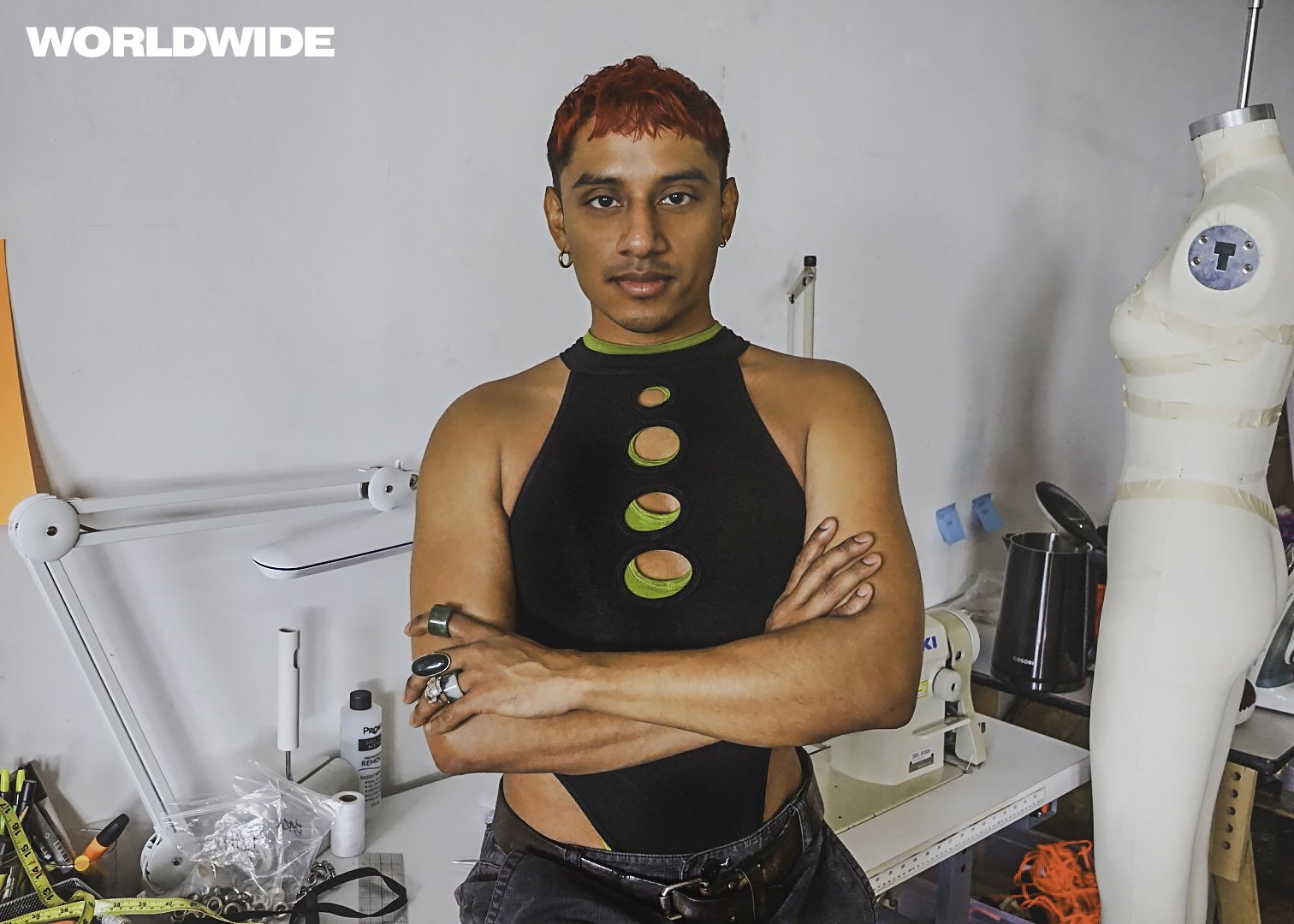WE ARE WORLDWIDE: LOUIS DORANTE X WORLDWIDE MAGAZINE
PHOTOS BY KE’MON CHAPMAN ★ TALENT LOUIS DURANTES ★ INTERVIEW BY ANDYOMO ★ FEATURING PIECES BY LEAK NYC
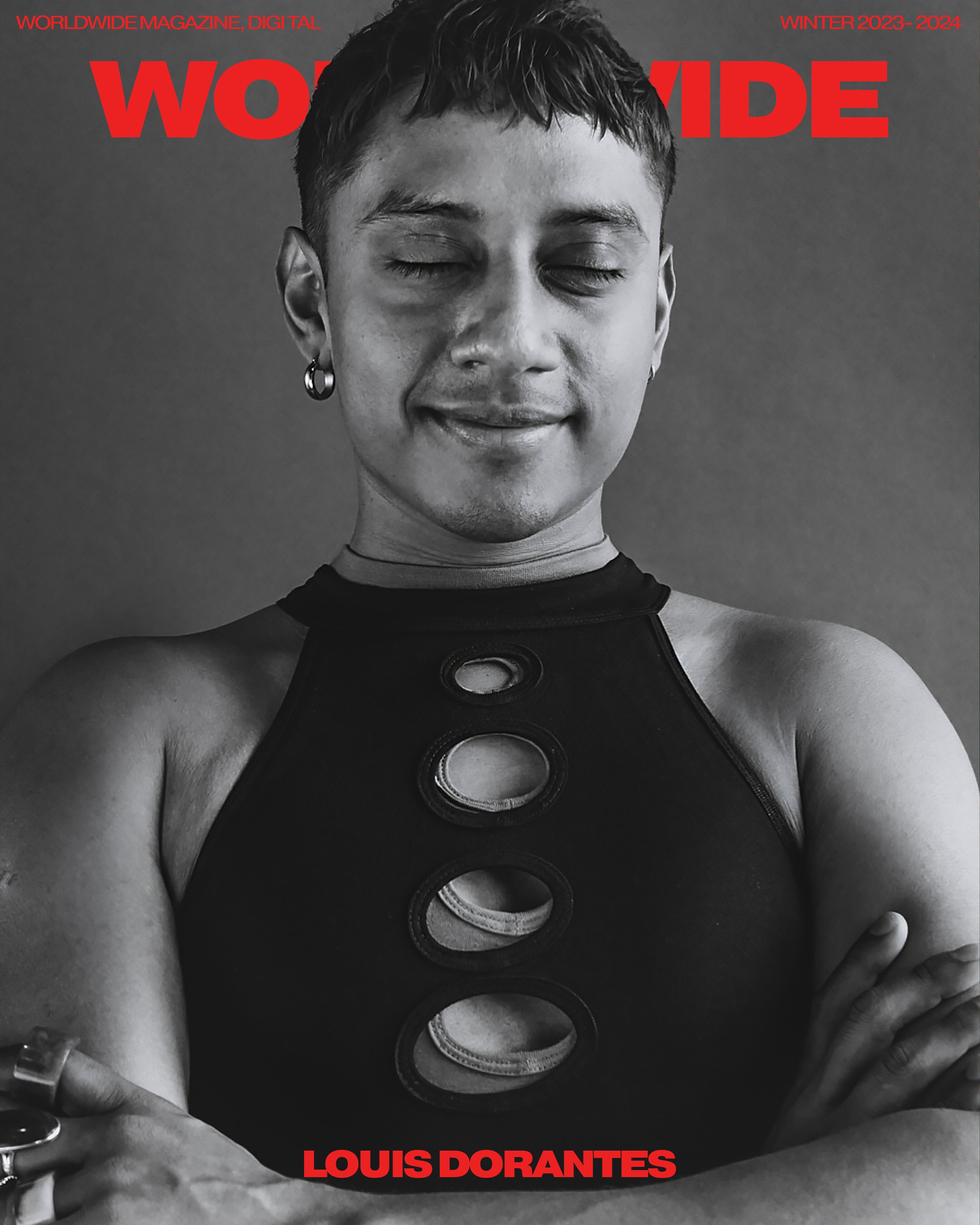
AndyOmo: Hi, Louis. How are you?
Louis: Amazing. Thank you so much.
We're so glad we could get a chance to talk to you about Leak and about you. Let's just start by introducing you to our audience. Can you tell me your name, pronouns, what industry you're in, and how long you've been in that industry?
My name is Louis Durantes, he/they, and I make lingerie for queer folks. I've been doing this specifically for four years now.
Four years now. And before New York, you were in the Midwest, right?
I grew up outside Detroit and I moved to New York 14 years ago.
Wow, it's been a second then. You're a New Yorker, as they might say. I love that. Were you always based in Brooklyn the whole time?
No, I've lived in the city before, but I love Brooklyn the most.
I love Brooklyn too. It has that homey charm for sure. I know that you originally were in Guatemala, right? And then you were in Detroit. What was that like in terms of everything being such different places?
Every place is different. I was born there, but I was raised in Detroit. So I spent most of my life in the Midwest.
There's a pretty big queer scene in Detroit, right?
It's getting more and more queer, more and more liberal, but it was not always like that.
It was a red state, and now it's kind of like Purple, I think. I grew up outside Detroit. I grew up Catholic and had Republican parents. That was tough, even though, I love my family and I love a lot of things about Detroit. It's a cultural hub itself. I think, as a queer person, there were a lot of things that were lacking in that environment.
I'm sure.
So, finally coming to New York was, was a bit of a culture shock, to say the least.
Did you always know that you wanted to design when you moved to New York?
Yeah, I wanted to do something in the arts. I thought I would do like evening wear. I guess I am, but not in the way I had imagined it in the first place. I thought I would be making gowns or something like that. After 10 years, like, I realized that the idea of creating evening wear with knit and lace
I've heard the term "slutgear"
Yeah, extremely, lewd garments. I think that's very kind of poetic.
I think I read that you went to Parsons, right? How was that?
I did go to Parsons, I studied there for four years. It was a great experience. Our curriculum sucked, but my peers were amazing. They were super talented, super good, well connected, they are super, like, everything. I kept in touch with a lot of them since we graduated. And every one of them has gone on to do amazing things. Some of us still work together, one of my business partners is from Parsons.
Would you say that the resources that you got from Parsons, and the community that came with that are a big part of how you ended up where you are?
Yeah, that goes without saying. It was a really strong group of designers that I graduated with. Even the ones that didn't even finish went on to do amazing things. I don't even know if you need that full degree, right? It was more of a self thing than something that you needed in the industry. It was more important to be social and open to working and have practical design skills. Not just theoretical ideas in a classroom.
Also, the equipment I'm sure that you had available to you guys too was very beneficial I'm sure too.
Oh, the equipment at Parsons sucked. That's why a lot of me and my classmates took classes at FIT and other institutions. To be completely honest, don't go to Parsons expecting to get like state of the art like sewing or knitting equipment.
That's so funny. It's good to know though, I think for people who are considering art schools.
It's bare bones and it's very conceptual. We do have that strength of ideas.
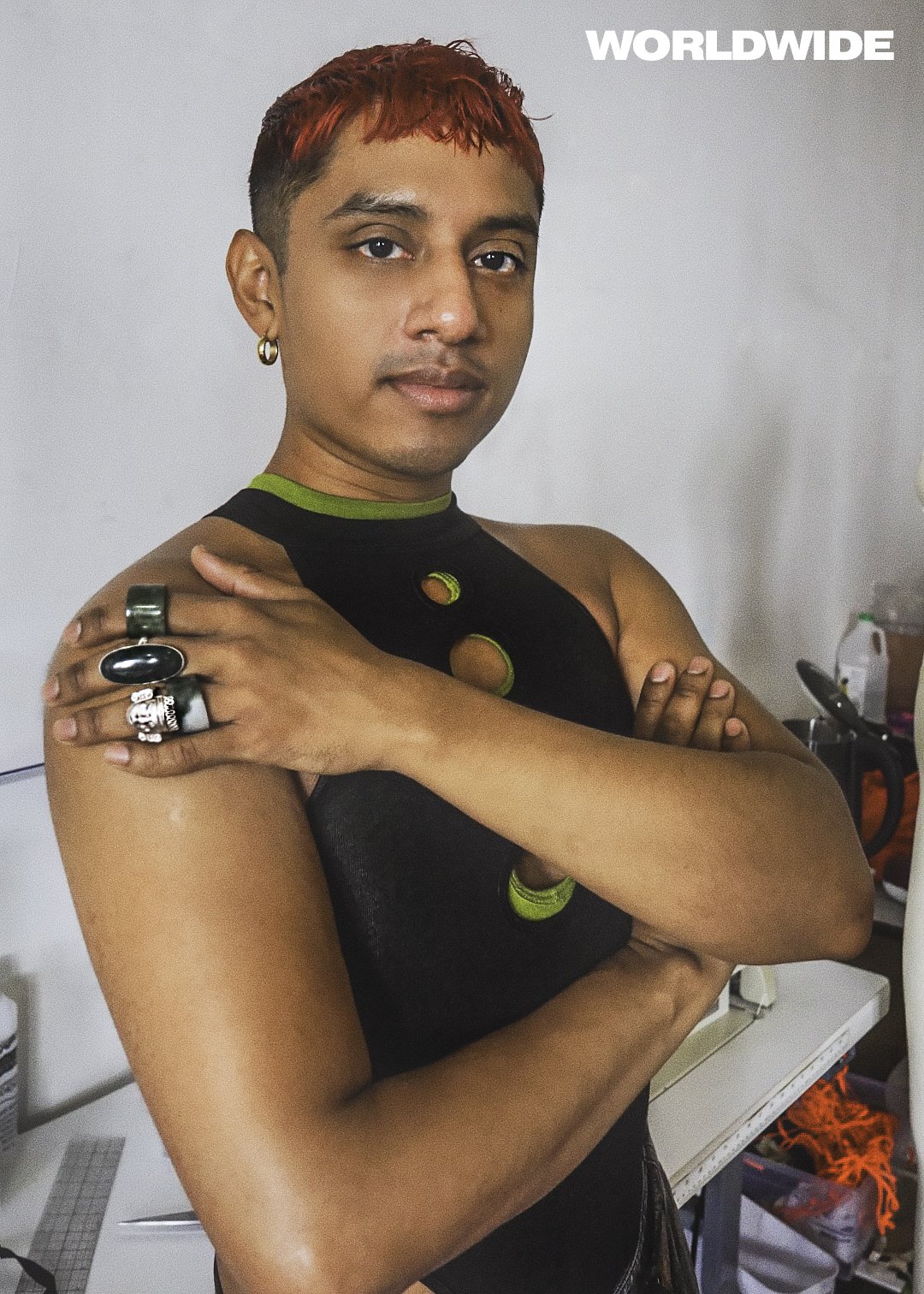
Got it. It does sound like the best reason to go to these schools is to connect with people and go through those situations together to now. I'm sure it's a big encouragement getting to watch and support each other. That's not something that a lot of Independent designers in the middle of nowhere, or outside of a big city, may necessarily feel so that's awesome.
I know in your last collection there were some more gowns, and a lot more draping, which was very different to see from you too, but now hearing you talk, it makes sense. When did you know that you wanted to get more into the specific textile work that you use now in your work versus evening wear where you started from? And then came full circle back around too?
My peers and the independent research that I did at Parsons, really influenced that a lot. And by the time I was, in my third year, I was very dedicated to the science and the method of knitwear and textile design specifically. You can really deep dive into it and there's a whole universe on how textiles are born and thread counts, and the science behind yarns and filament threads, which is what we use here at Leak. A lot of synthetic yarns. Some of the things that we're doing now are not so synthetic, but Leak was born using synthetic yarns that had a lot of durability, a lot of breathability, and obviously is super, super stretchy. Those are hard things to put inside of one yarn and in one textile. All of that knowledge was already collecting and inspiring my way back up to 10 years ago, I'd say now.
I know we talked a little bit off the mic but I was telling you that the first time I saw your work was on Ziggy for that coach bag.
Ziggy Mac.
I will say I remember seeing your use of D rings on that and seeing how that's kind of turned into the work you do now. When did you enter more into the jewelry aspect of your design too?
Jewelry and metal smithing I had done before going to Parsons. That was one beautiful thing about Detroit. There were a lot of craftsmen, a lot of jewelers, independent small jewelers that showcased at fairs and things like that. There are a lot of workshops and local artisans that helped me learn about metalsmithing and jewelry making, specifically, I've always been fascinated by those techniques. I didn't have an opportunity to explore it to its full extent, mostly because I was just doing it after school. I'm super excited to get back into making costume jewelry, I'd say. Super loud, not terribly inaccessible, but very queer, very glitzy.
There is a sense of elegance in your latest collection, but still with this juxtaposition of it being a lot of smutty wear, too. It is cool to see that integration. Every single time I've seen new aspects of your brand, it always throws me for a loop honestly. Like I'm thinking of this person as the mesh person. No, they're not the mesh person. You know what I mean? Like they're playing with different types of textiles while mixing different types of material. Now they're doing jewelry. It's cool to see how those all exist in the same room, with Leak and with your work as a whole. I feel, from an outside point of view, you get to see little parts of you through those different types of materials as well. It has been cool to witness the evolution of Leak, especially with the latest collection playing a bigger part, too, on these different uses of costume jewelry, unique textile work, and your draping work in your gowns. Red carpet. Absolutely.
Thank you.
Would you describe your community as a POC person and as a queer person here in the city, but also in general as playing an essential role in the building and growth of LEAK?
Yeah. When I was inspired to first create the brand, I would be going out to queer POC spaces in Brooklyn, getting inspired by them, getting inspired by a lot of femme energy. The whole brand also started evolving around, who is the Leak customer, who is the Leak talent, and who do I want to represent? And it was a lot of queer POC folks, that I felt were part of the underwear industry were just very much excluded from campaigns that you would normally see from any brand, like Calvin Klein, or even the gay, local brands, not gonna name names.
No, but you're right. A lot of them do have that kind of poster look.
It's very specific, I'm sure it drives a lot of sales, but brands like Savage Fenty did not exist, and I very much wanted it to be colorful, queer, and brown and black.
I will say that, like, I do find within your brand a lot of comfort within gender expression. Especially if we're talking about this poster boy, here in New York City where they have a stereotypically masculine physique. Then you see people like making it femme. It's exciting to kind of see people play into that because of the clothes that you made. Did you see that coming? Did you see people getting very comfortable within this new era of expression?
Yeah. I mean, I always wanted to see more of it and I wanted people to feel comfortable expressing it. I hoped this day would come, I think we can take it a few steps further. We still revolve a lot of our campaigns and a lot of the day-to-day, around getting people even more comfortable with those ideas with de-gendering fabrics, specifically lace or specific silhouettes. It's still a very radical idea for a male presenting person, let's say, to wear, particularly effeminate clothing or fabric.
You're part of that narrative, though, when it comes to breaking down what it means to express oneself, femininely and masculinely.
We have a lot of work to do to break it down. But I'm happy to contribute.
That was well said. Coming from a traditionally Catholic background where sexuality was not celebrated but in some cases, overlooked altogether in conversation with family, how has that influenced your work and the messages you hope to convey to your audience?
I mean my sexuality was very suppressed, let alone not celebrated. When I moved to New York, there was this explosion of provocative energy that I needed to put out into the world. Hooking up also wasn't the answer to the issues I was having. I wanted other people to know what I was feeling also and put all of this excitement and freedom into something more productive. So I started making stuff that I wish I had growing up.
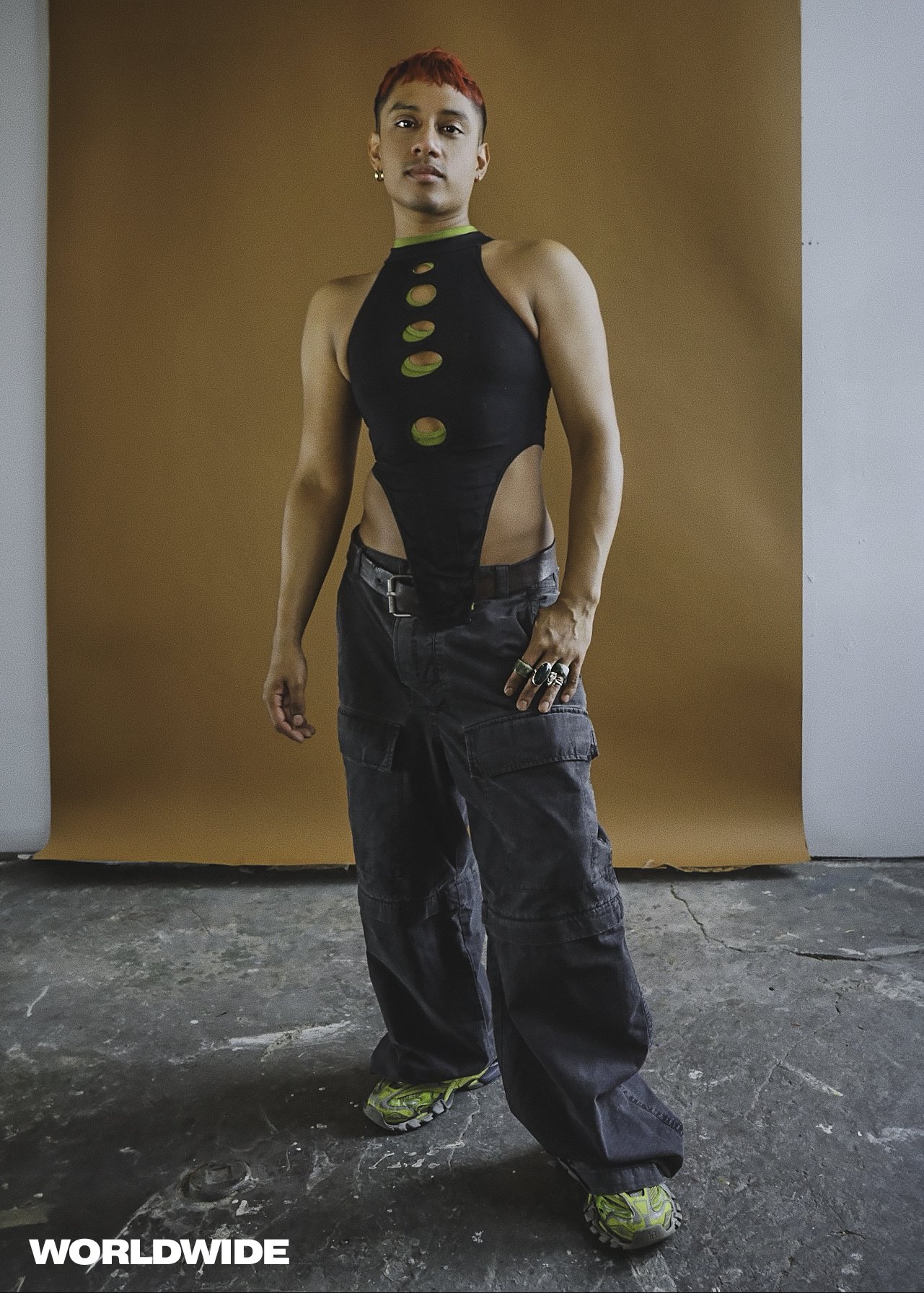
Right, helping to fill the gap.
Yeah, and that's a mission that I'm still fulfilling. There's a lot of time and resources that go into textile development and making hardware, but in a lot of ways I'm still playing catch up and trying to finish making all the things that, again, I wish I had and was prevented from enjoying growing up in that catholic environment.
I'm sure there's a lot of liberation that comes from being able to now look in your closet and feel like there's you. And I'm sure that that's something that the Leak customer can feel.
I know we kind of mentioned it too, but it's awesome to see Leak on all sorts of body types and all genders. I truly do see that, especially living in the heart of Brooklyn. As a queer person, from my own experiences, it can be very hard to look in my closet and feel constricted by what I feel safe in, what I feel comfortable in, and even what the young me told me is okay too. So I do feel that even just one of your pieces is one of those things that makes people feel extremely proud to know that they own these things that make them feel this way. I get what you mean in the sense of repression, and the sense of liberation, too, coming to New York. I don't know if everyone in the world will ever get that feeling, so that's one of those things where I recognize that at least some of us are very privileged to be in a space where we have access to that community. I also understand the opposite side of that coin though, where most of us came from a place that wasn't that way and where you're fighting to create a world you want to live in, which something as simple as clothes, can do that. So, that's awesome.
Liberation and resistance through, design, are my thoughts.
It is expression. It's letting the clothes do the talking so that you don't have to say anything. Do you have a favorite piece/collection of yours? Even things from before Leak or something you've worked on, like a special project?
Yeah, I mean, everything that I'm developing or I put out into the universe I genuinely would want to wear myself. That's a really important aspect of our design process. I'm not going to try to sell you something that I wouldn't want to use myself. In that sense, yeah, there are so many things I'm excited about and every piece is like a child, right? It's born and raised and refined and refined over and over again. I love this one that I'm wearing right now. It's an element bodysuit. It's very comfortable. I made it when I was in my cozy era. I was like, I want to wear something soft and kind of streamlined, um, not sheer for once, like I feel like I could wear this out.
You could put a blazer on it.
Yeah, and then wear it to dinner, you know, that kind of thing.
You could be studying in the library!
Yeah, it's more versatile, it's a different vibe, and I want to be able to break out of nightlife, where I think we've been centered and we have a stronghold.
What's cool about New York is there are a lot of people that do wear nightlife clothing out during the day. Those who might have specific styles, stylists too, and people who are committed to their look. It is cool to see that leave the night, and back into the daytime. Like you said, this is very comfortable and yet very you. I love to see it.
Diving into other creative outlets, is there anything that you do for yourself specifically that is good for your mental health or good for your emotional health, that's maybe not designing specifically?
Got you. It feels like most of my life has been so focused on the brand, everything just kind of revolves around the larger picture, as a company. But lately, I've just been taking walks, reverting to sketching, and not like fashion illustration, but just like figure drawing. That's therapeutic for me because that's where I started. I would just draw illustrations with Chartpak markers and Micron pens. I love pens. I found these beautiful Japanese ballpoint pens that were designed to write on fabric, but I just liked the way they interact with cardstock and it's like super super fluid. It's almost like having a fountain pen.
That's fun. I like to say I like to draw but I'm not good at it. That's one of those arts that's hard for me. It is important I think, as artists to make sure that we're creating art for us. A lot of people can feel the pressure of selling themselves, so I think it's important to do things that bring us back to earth and make us feel like us. I think drawing is great, but even taking a walk, seeing the city, getting outside, taking that time for you. So that's awesome.
Do you have any dreams, like, projects slash collaborations? Like, what's the biggest you could dream of?
I'd love to collaborate with Nike, like an official one.
That'd be hot.
When we first started, I would take sports bras or jerseys from Nike and take off all the trims, take them apart to their foundational elements, and rework them into something hyper-sexualized and something I wanted to wear out to like a sex party or something. To get a big brand, to get behind an aesthetic like that would be an amazing accomplishment.
Totally. I think that's not even far out from your wheelhouse. I think it's definitely in the works. You gotta trust the universe. Last question, are there any big projects after this one that you're already working on? Is your brain, like, already focused on the next, the new? Or are you taking time to revel in this collection and everything that's happening now?
Yeah, all of the above. You have to save some space to appreciate the show that we just had.
That took you a couple of years, right, to plan, if I remember reading it right?
It took a while, it took several years to save up to be able to do that.
Got it. Right, it's not cheap.
I did not have someone pay for my first collection, and I learned a lot from that experience. It was beautiful, so emotional, and important to me, and, I'm glad all the people who contributed to the brand, even from day one, were able to be in one place and celebrate that moment with us. So grateful.
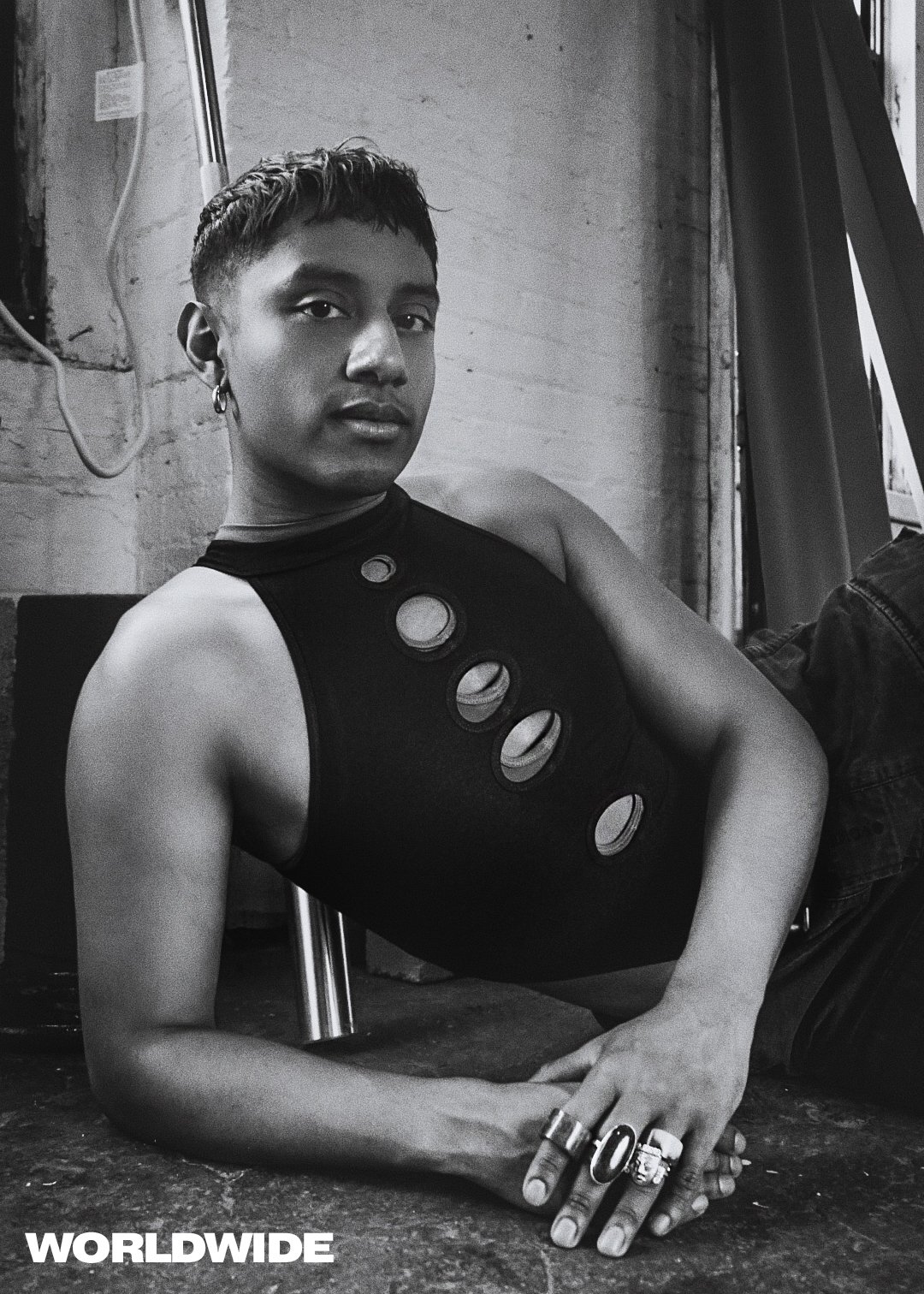
It was cool to see the community. So many different types of people in there that all had a passion, for not just fashion, but for expression. I think that was so cool, not that I was a part of a group of people, but more of a part of a generation. You know what I mean? You get to look around and it's not like the 70s where everyone looks the same. Everyone here looked so different, so that's what was cool for me about your show, the second I walked in. Then never knowing what to expect-
[Laughs]
- I think, was a big part too.
It's so funny.
I genuinely was caught off guard every time in the best way possible. Them coming out in duos, seeing my friends walk through with your clothes, it was just so different than anything I've seen in a couple of years now. To see the dancing with the sexuality, to see the background and the way they interacted, them three, while the people on stage were interacting, it was cool. It was cool. I know that that was a collaboration with your creative director for that, right? Yeah. Remind me of her name.
Sebastian Hernandez (she/they).
[Sebastian] coming out there covered in blood too, was so iconic. How long have you been working together with them?
2020 I believe was our first DIY campaign that we did in Los Angeles. We had all just been hanging out at the beach and then I showed them some of the pieces and they got inspired when we finally got back to our hotel, trying stuff on. I remember we had a mutual friend, Jaime, so Jaime and I interacted in our hotel room, which was floor to ceiling windows, and then Sebastian ran around to the other side of the building so that they could take very voyeuristic photos of us, and I think that was a pivotal campaign that just came out of nowhere. It was so organic and fun but it's one of the [campaigns] that a lot of people remind me about, that stuck in their head.
I do get this sense of voyeurism within your work. I remember seeing these photos of Silas in the mountains or something, where I felt like I almost saw something I wasn't supposed to
[Laughs]
Like, "Oh my god, I just went on a hike and saw these random gays in the forest," In the best way organic, as you said. Not only were the colors and the energy there, it just felt right. It's cool to see how collaborative minds come together. It's just all trust, right? Trusting that other person.
Yeah, there's a lot of trust involved.
Because multiple brains coming together is a plus. It's a positive thing, but it's also hard to get that _click_, sometimes.
Right, because it's so provocative, because it's so, intimate. One of the biggest challenges I had when I first started, was just developing a small group of friends that trusted that I had a strong vision. I had no lingerie portfolio to show them. It was just literally all in our hearts and our minds and we just ran with the ideas. It's a little easier to meet people now because we have this whole brand, [and] this very specific vision, but that sense of trust never changes.
And that is rare.
All the talent that you see like on our Instagram, all the photographers that we work with, we're friends. I don't just do the normal style of castings and work with strangers, right?
It is cool to see you guys back each other, 'cause I know that It is so easy to feel alone in an industry like this, not to mention a city like this. So, that's amazing that you met Sebastian and that you have that core group of people.
The last question I have is how can we create more space and opportunities for other POC creatives looking to break into this industry.
Got you. Yes, such an important question. Going almost back to your original question about what we're working on and big projects, I think one of the biggest projects that we have going on now is continuing to do some kind of presentation, some kind of show to, be able to bring together, not just like the talent, but other types of talent. Lighting designers, graphic designers, movement artists, painters. For the show, we also had an amazingly talented set designer. Bringing together different artists, like unconventional creatives, maybe not necessarily creatives who identify as artists, but bringing them together to, create something that, represents our customers and our community in different media, is going to be important. It strengthens the community and helps create visibility, but also getting them paid for the amazing work that they have is a really important community idea. It's not just a show to sell stuff. It's supposed to be a platform to highlight many other aspects of design creativity and expression. That's what we're working on.
I love to see artists supporting artists. There's a lot of talk always about gatekeeping and a lot about trying to make sure that you take care of yourself and your own. So it is awesome to see people that come together, be able to find common interests, but also be inspired by each other, you know? As you said, they don't always have to be quote-unquote artists to be creative or to be inspired by each other to create something cool. So, that's awesome. I think that a lot of readers will get this kind of inspiration from you and your story. And I appreciate you taking the time to do that and talk with us. It was a blast.
Of course, thank you!
